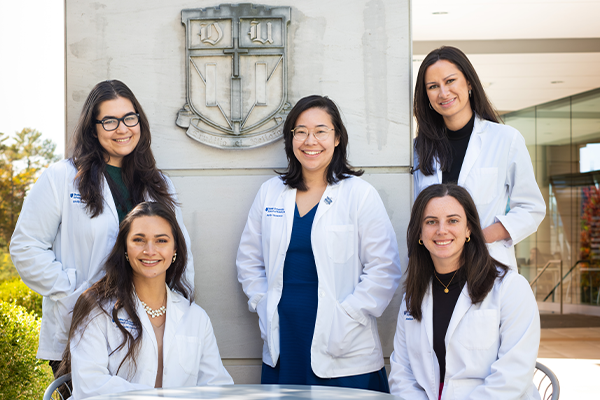
When Emily Alway first arrived at Duke in 2019 as an MD/PhD student, she wasn’t sure if she would be the only Native American student in her medical school class. Throughout her life it had been a common experience. A citizen of the Lumbee Tribe, she was later happy to learn that in fact, she wasn’t alone. She met a few others who identified as Native or Indigenous, including Marilyn Yamamoto. Together, the two made it their mission to help others find similar connections and a sense of community during their time in medical school.
After discovering that no affinity group existed at Duke University School of Medicine for Native and Indigenous students, Alway and Yamamoto created the Native and Indigenous Medical Student Association in fall 2022.
“One thing that’s shared among a lot of individuals in the Native community is the aspect of being the first or being the only one, and just feeling like you're swimming in a sea alone,” said Yamamoto, a fourth-year medical student. “In medical school that can be really daunting. Finding other people who have gone through the same path, the same trials, struggles, it really helps.”
Knowing who identifies as Native American or Indigenous isn’t always easy to determine. So, Yamamoto said, a group like this one is especially helpful for students seeking community. The group made a point to be inclusive, welcoming students who are native Hawaiians, like Yamamoto, and native Pacific Islanders.
Alway and Yamamoto currently serve as co-presidents and are part of the group’s five-member executive team. The group has hosted social events for students and fundraisers, including one for the Animal Protection Society of Durham and another to raise funds for the Native Hawaiian community after the Maui wildfires in August.
A major focus of the Native and Indigenous Medical Student Association is helping students find mentors. Alway and Yamamoto said it is not always apparent where to look for role models. Native or Indigenous clinicians make up just 0.4% of the physician workforce.
“That is such a tiny number, compared to the amount of people who are Native and Indigenous in America,” Yamamoto said. She emphasized the importance of showing “aspiring physicians that there are people who look like them and have grown up like them, and it's possible to go out there and be a physician.”
When forming the group, Alway said not only did they hope to attract Native and Indigenous students that others can look up to, but they also sought to create a space where students feel they belong.
She said they want prospective students to know Duke is “not only a place where they're going to be tolerated and able to exist, but it's going to be a place where the cultural background that they come from is really celebrated, too.”
The group also hopes to offer representation for patients at Duke, sending the message that Duke cares about the health care of Native and Indigenous populations.
“There's a lot of cultural trauma that Indigenous people have had to deal with, especially when interfacing with the health care workforce,” Yamamoto said. She added that it is important to demonstrate to patients that “there are people who are just like you, who have gone through what you have, and are here trying their best to advocate for you in the health care system.”
Hannah Woriax, MD, who is one of the group’s faculty advisors and a citizen of the Lumbee Tribe, knows all too well the importance of mentorship and representation. Her grandfather was the first Native American student to attend medical school at Duke, and her father graduated from the Duke Physician Assistant Program in the 1990s. Despite having a legacy of Duke-educated providers in her family, Woriax, an assistant professor of surgery, had very few role models in her chosen specialty as a medical student.
“I didn't know that other Native American surgeons existed,” Woriax said. She added that many of today’s students may find it difficult to imagine themselves in certain positions because of the lack of role models. She hopes the Native and Indigenous Medical Student Association will help change that.
Woriax said she experienced racism while interviewing for residencies 10 years ago. She felt she had to “smile and be nice” during those unfortunate encounters but wishes there had been someone there for her who could have better prepared her. She hopes that she and other providers and residents both inside and outside of Duke can fill that role for students in the Native and Indigenous Medical Student Association.
“It's nice to be able to provide insight for the students that these mindsets still exist, and say, ‘Here's how we’re going to work through them, here’s how we offer you lots of resources,’” she explained. Woriax said she hopes connecting students to role models will ultimately give the students a voice, allowing them to “build the life that they want, and have their experience not differ from the majority's experience, especially in a land that's ours, but we're easily forgotten about.”
The student leaders of the Native and Indigenous Medical Student Association are planning to host a panel discussion with Native and Indigenous physicians within the community later in the academic year. They also hope to establish partnerships with similar organizations on campus, including the Native American Graduate and Professional School Alliance. They have already connected with Duke’s undergraduate organization, the Native American/Indigenous Student Alliance, and have plans to work with the group to create a mentorship program for undergraduates interested in careers in medicine.
Photo caption: Members of Duke’s Native and Indigenous Medical Student Association executive team: (Back row, left to right) Emily Alway, MD/PhD candidate; Marilyn Yamamoto, fourth-year medical student; and Seneca Oxendine, MD/PhD candidate. (Front row, seated left to right) Kristina Dunworth, fourth-year medical student, and Melissa Greene third-year medical student.
Photo by Rajha Tahir at Huth Photo